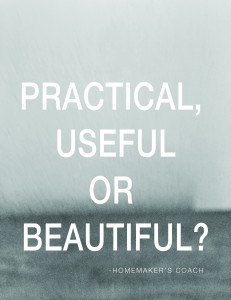 In 1930, an unknown writer stated:
In 1930, an unknown writer stated:
“The use of any possession presupposes a plan or philosophy of use.”
————————————- ————————————-
The term “philosophy of use” means “In what capacity are you going to use X ?” In other words—as it relates to having an organized home or to organizing your belongings—before you decide to keep an item, you ought to know why you are doing so. Why did you obtain the possession in the first place? What plan of action were you following that indicated you needed that item? Are you still following that plan? What “philosophy of use” is causing you to still keep it? Your plan of action or “philosophy of use” then becomes the criteria or measurement by which you determine whether or not to keep a particular belonging.
For example, my overall “philosophy of use” says that whatever I obtain or possess should be one of two things. It should be either very practical—very useful to accomplish tasks—or it should be so beautiful that I cannot bear to be without it. This is why I have clever tools in my kitchen, bookshelves full of hundreds of books—yes, organized by category—and inspiring artwork hanging on the walls. The very practical and the very beautiful nourish my soul and improve my life to the degree that the former helps me do my work effectively and the latter brings beauty to my surroundings and inspires my own personal creativity. These are the two criteria that help me purposefully determine what I will or will not keep in my home.
Be clear on why you are keeping what you are keeping. The more you are aware of your own “philosophy of use” the better you will be at deciding what possessions to get rid of or keep. It might even help you avoid a few moments of “mindless consumerism” in the stores—which might be a very beautiful thing for your wallet.
